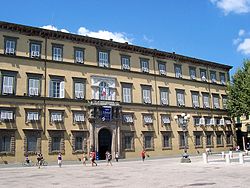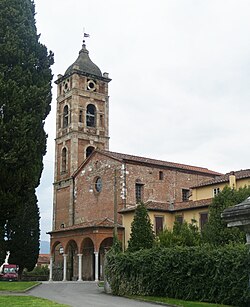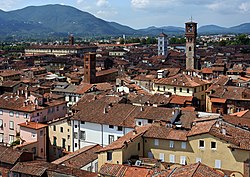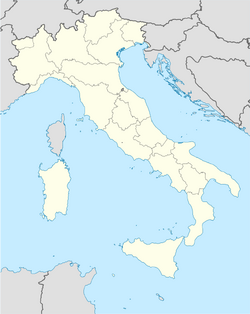| Main | Births etc |
|---|
| Lucca | |||
|---|---|---|---|
| — Comune — | |||
| Comune di Lucca | |||
| Panorama of Lucca from the Torre Guinigi | |||
|
|||
| Coordinates: | |||
| Country | Italy | ||
| Region | Tuscany | ||
| Province | Lucca (LU) | ||
| Frazioni | see list | ||
| Government | |||
| • Mayor | Alessandro Tambellini ([[List of political parties in Italy|PD]]) | ||
| Area | |||
| • Total | 185.5 km2 (71.6 sq mi) | ||
| Elevation | 19 m (62 ft) | ||
| Population (30 November 2012)[1] | |||
| • Total | 87,467 | ||
| • Density | 470/km2 (1,200/sq mi) | ||
| Demonym | Lucchesi | ||
| Time zone | CET (UTC+1) | ||
| • Summer (DST) | CEST (UTC+2) | ||
| Postal code | 55100 | ||
| Dialing code | 0583 | ||
| Patron saint | St. Paulinus | ||
| Saint day | July 12 | ||
| Website | Official website | ||

Duomo di San Martino (the Cathedral).
Lucca (Italian pronunciation: [ˈlukka] ( listen)) is a city and comune in Tuscany, Central Italy, situated on the river Serchio in a fertile plain near the Tyrrhenian Sea. It is the capital city of the province of Lucca. It is famous among other things for its intact Renaissance-era city walls.[2][3]
History[]
Ancient and medieval city[]
Lucca was founded by the Etruscans (there are traces of a pre-existing Ligurian settlement) and became a Roman colony in 180 BC. The rectangular grid of its historical centre preserves the Roman street plan, and the Piazza San Michele occupies the site of the ancient forum. Traces of the amphitheatre can still be seen in the Piazza dell'Anfiteatro.
At the Lucca Conference, in 56 BC, Julius Caesar, Pompey, and Crassus reaffirmed their political alliance known as the First Triumvirate.[4]

Piazza Anfiteatro and the Basilica di San Frediano.
Frediano, an Irish monk, was bishop of Lucca in the early 6th century.[5] At one point, Lucca was plundered by Odoacer, the first Germanic King of Italy. Lucca was an important city and fortress even in the 6th century, when Narses besieged it for several months in 553. Under the Lombards, it was the seat of a duke who minted his own coins. The Holy Face of Lucca (or Volto Santo), a major relic supposedly carved by Nicodemus, arrived in 742. During the 8th - 10th centuries Lucca was a center of Jewish life, the Jewish community being led by the Kalonymos family (which at some point during this time migrated to Germany to become a major component of proto-Ashkenazic Jewry). Lucca became prosperous through the silk trade that began in the 11th century, and came to rival the silks of Byzantium. During the 10–11th centuries Lucca was the capital of the feudal margraviate of Tuscany, more or less independent but owing nominal allegiance to the Holy Roman Emperor.
First republic[]
After the death of Matilda of Tuscany, the city began to constitute itself an independent commune, with a charter in 1160. For almost 500 years, Lucca remained an independent republic. There were many minor provinces in the region between southern Liguria and northern Tuscany dominated by the Malaspina; Tuscany in this time was a part of feudal Europe. Dante’s Divine Comedy includes many references to the great feudal families who had huge jurisdictions with administrative and judicial rights. Dante spent some of his exile in Lucca.
In 1273 and again in 1277, Lucca was ruled by a Guelph capitano del popolo (captain of the people) named Luchetto Gattilusio. In 1314, internal discord allowed Uguccione della Faggiuola of Pisa to make himself lord of Lucca. The Lucchesi expelled him two years later, and handed over the city to another condottiere, Castruccio Castracani, under whose rule it became a leading state in central Italy. Lucca rivalled Florence until Castracani's death in 1328. On 22 and 23 September 1325, in the battle of Altopascio, Castracani defeated Florence's Guelphs. For this he was nominated by Louis IV the Bavarian to become duke of Lucca. Castracani's tomb is in the church of San Francesco. His biography is Machiavelli's third famous book on political rule. In 1408, Lucca hosted the convocation intended to end the schism in the papacy. Occupied by the troops of Louis of Bavaria, the city was sold to a rich Genoese, Gherardino Spinola, then seized by John, king of Bohemia. Pawned to the Rossi of Parma, by them it was ceded to Mastino II della Scala of Verona, sold to the Florentines, surrendered to the Pisans, and then nominally liberated by the emperor Charles IV and governed by his vicar. Lucca managed, at first as a democracy, and after 1628 as an oligarchy, to maintain its independence alongside of Venice and Genoa, and painted the word Libertas on its banner until the French Revolution in 1789.[6]
After Napoleonic conquest[]

Palazzo Pfanner, garden view.
Lucca had been the second largest Italian city state (after Venice) with a republican constitution ("comune") to remain independent over the centuries.
In 1805, Lucca was conquered by Napoleon, who installed his sister Elisa Bonaparte Baciocchi as "Queen of Etruria".
After 1815 it became a Bourbon-Parma duchy. The only duke of Lucca was Charles II, Duke of Parma, though between 1815 and 1824 his mother, Maria Luisa of Spain, was a regent. After his death, in 1847, Lucca lost independence and became part of Tuscany and finally part of the Italian State.
Main sights[]

View of Lucca from the Clock Tower.

Autumn in Lucca.

Via Fillungo from the Clock Tower.

Giglio theater.

San Michele in Foro.

City Walls
The walls around the old town remained intact as the city expanded and modernized, unusual for cities in the region. As the walls lost their military importance, they became a pedestrian promenade which encircled the old town, although they were used for a number of years in the 20th century for racing cars. They are still fully intact today; each of the four principal sides is lined with a different tree species.
The Academy of Sciences (1584) is the most famous of several academies and libraries.
The Casa di Puccini was re-opened to the public on 14 September 2011.[7] At the nearby town of Torre del Lago, there is a Puccini opera festival every year in July/August. Puccini had a house there as well.

Ducale Palace.

The Passeggiata delle Mura.

Church of San Michele of Antraccoli.
There are many richly built medieval basilica-form churches in Lucca with rich arcaded façades and campaniles, a few as old as the 8th century.
- Piazza dell'Anfiteatro
- Piazzale Verdi
- Piazza Napoleone
- Piazza San Michele
- The Ducal Palace, built on the location of Castruccio Castracani's fortress. The original project was begun by Bartolomeo Ammannati in 1577–1582, and continued by Filippo Juvarra in the 18th century.
- The ancient Roman amphitheatre
- Torre delle ore ("The Clock Tower")
- Casa and Torre Guinigi - The Guinigi Tower with oak trees on top
- National Museum of Villa Guinigi
- National Museum of Palazzo Mansi
- Orto Botanico Comunale di Lucca, a botanical garden dating from 1820
- Palazzo Pfanner
- Villa Garzoni, noted for its water gardens.
- Passeggiata delle Mura Urbane, a street all over the city on the bastions. It passes from these balconies: Santa Croce, San Frediano, San Martino, San Pietro/Battisti, San Salvatore, La Libertà/Cairoli, San Regolo, San Colombano, Santa Maria, San Paolino/Catalani, and San Donato; also pass over these gates: Porta San Donato, Porta Santa Maria, Porta San Jocopo, Porta Elisa, Porta San Pietro, and Porta Sant'Anna.
- The fortified city is surrounded by the streets of: Piazzale Boccherini, Viale Lazzaro Papi, Viale Carlo Del Prete, Piazzale Martiri della Libertà, Via Batoni, Viale Agostino Marti, Viale G. Marconi (vide Guglielmo Marconi), Piazza Don A. Mei, Viale Pacini (vide Pacini), Viale Giusti, Piazza Curtatone, Piazzale Ricasoli, Viale Ricasoli, Piazza Risorgimento (vide Risorgimento) and Viale Giosuè Carducci (vide Giosuè Carducci).
Churches[]
- Duomo di San Martino: St Martin's CathedraL
- San Michele in Foro church
- San Giusto: Romanesque church
- Basilica di San Frediano
- Sant'Alessandro church,[8] an example of medieval classicism
- Santa Giulia church with Lombard origins, but remade in the 13th century.
- San Michele church at Antraccoli. Founded in 777, it was enlarged in the 12th century and modified again in the 16th century with the introduction of a portico.
- San Giorgio church in the locality of Brancoli, built in the late 12th century. It has a nave and two aisles with a single apse, and a bell tower in Lombard-Romanesque style ranked among the most beautiful in northern Italy. The interior houses a massive ambo (1194) with four columns mounted on notable sculptures of lions. Also having notable medieval decoration is the octagonal baptismal fount. The altar is supported by six small columns with human figures
Culture[]
Lucca is the birthplace of composers Giacomo Puccini (La Bohème and Madama Butterfly), Nicalao Dorati, Francesco Geminiani, Gioseffo Guami, Luigi Boccherini, and Alfredo Catalani. It is also the birthplace of Bruno Menconi and artist Benedetto Brandimarte.

Guinigi Tower
Museums[]
- National Museum of Villa Guinigi
- Museum of Villa Mansi
- Museo della Cattedrale
- Lu.C.C.A. Museum of the Archaeology of the Lucca Cathedral
- Orto Botanico Comunale di Lucca
Events[]
Lucca annually hosts the Lucca Summer Festival. The 2006 edition saw Eric Clapton, Placebo, Massive Attack, Roger Waters, Tracy Chapman and Santana play live in the Piazza Napoleone.
Lucca hosts the annual Lucca Comics and Games festival, Italy's largest festival for comics and related subjects.
Other events include:
- Lucca Film Festival[9]
- Lucca Digital Photo Fest[10]
- Procession of Santa Croce, on 13 of September. Costume procession through the town's roads.
- Lucca Jazz Donna[11]
Film and television[]
Mauro Bolognini's 1958 film Giovani mariti with Sylva Koscina is set and was filmed in Lucca.
Lucca was featured on Top Gear during a Hot Hatch comparison in Episode 2 of Season 17. The city's narrow and one-way street layout played a large role in the segment.
International relations[]
Lucca is twinned with:
Abingdon, United Kingdom
 Colmar, France
Colmar, FranceGogolin, Poland
 Schongau, Germany
Schongau, GermanySint-Niklaas, Belgium
Buenos Aires, Argentina
Lucca Sicula, Italy
Panther's Contrade, Siena
South San Francisco, United States of America
People[]

Vincenzo Lunardi.
- St. Anselm of Lucca, (1036–1086), bishop of Lucca
- Giovanni Arnolfini, merchant and arts patron
- Pompeo Batoni, painter
- Simone Bianchi, comics artist[12]
- Luigi Boccherini, musician and composer
- Elisa Bonaparte, ruler of Lucca
- Castruccio Castracani, ruler of Lucca (1316–1328)
- Alfredo Catalani, composer
- Gusmano Cesaretti, photographer and artist
- Mario Cipollini, cyclist
- Matteo Civitali, sculptor
- Ivan Della Mea, singer-songwriter
- Theodor Döhler, composer and pianist; lived in Lucca from 1827–1829
- Ernesto Filippi, football referee
- Saint Frediano
- St. Gemma Galgani, mystic and saint
- Tejay van Garderen, cyclist
- Francesco Geminiani, musician and composer
- Agostino Giuntoli, nightclub owner and entrepreneur
- Gioseffo Guami, composer
- Pope Lucius III
- Vincenzo Lunardi, pioneer aeronaut [13]
- Felice Matteucci, engineer
- Leo Nomellini, athlete
- Marcello Pera, politician and philosopher
- Giacomo Puccini, composer
- Marco Rossi, athlete
- Renato Salvatori, actor
- Rinaldo and Ezilda Torre, founded the Torani syrup company in San Francisco using Luccan recipes from their hometown
- Rolando Ugolini, athlete
- Giuseppe Ungaretti, poet
- Antonio Vallisneri, scientist and physician
- Alfredo Volpi, painter
- Saint Zita
- Zita of Bourbon-Parma, last Empress of Austria
See also[]
- Castruccio Castracani
- Duchy of Lucca
- Republic of Lucca
Footnotes[]
- ^ Population data from Istat
- ^ Magrini, Graziano. "The Walls of Lucca". Scientific Itineraries of Tuscany. Museo Galileo. http://brunelleschi.imss.fi.it/itineraries/place/TheWallsOfLucca.html. Retrieved 25 March 2013.
- ^ Boatwright, Mary et al. The Romans: From Village to Empire, pg 229.
- ^ See article on the Basilica di San Frediano.
- ^ Encyclopædia Britannica (1911)
- ^ "Puccini Museum - Casa natale". http://www.fondazionegiacomopuccini.it/page.php?page=31&langId=1. Retrieved 2011-06-29.
- ^ "Church of Sant'Alessandro Maggiore | Lucca". Tuscanypass.com. 2010-12-16. http://www.tuscanypass.com/tuscany_attractions/13131_church-of-sant-alessandro-maggiore.html. Retrieved 2013-03-26.
- ^ Lucca Film Festival
- ^ Lucca Digital Photo Fest
- ^ Lucca Jazz Donna
- ^ "About" SimoneBianchi.com. Retrieved March 25, 2012.
- ^ The Quarterly review, Volume 139 Google Books
Further reading[]
- "Lucca", Italy (2nd ed.), Coblenz: Karl Baedeker, 1870, http://archive.org/stream/italyhandbookfor04karl#page/n391/mode/2up
- "Lucca", Northern Italy (14th ed.), Leipzig: Karl Baedeker, 1913, http://www.archive.org/stream/northernitalyi00karl#page/528/mode/2up
External links[]
Template:Province of Lucca
| This page uses content from the English language Wikipedia. The original content was at Lucca. The list of authors can be seen in the page history. As with this Familypedia wiki, the content of Wikipedia is available under the Creative Commons License. |




